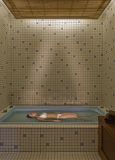Cosmopolitan Spa Therapies
Flotation:

Flotation is a treatment not recommended if you are claustrophobic or lygophobic (afraid of the dark), for it involves floating in an enclosed tank or pool of water about 25 centimetres / 10 inches deep in complete darkness or very little light. A two-hour floation session is equivalent to eight hours of deep sleep. The first flotation tank was designed in the 1950s by Dr. John C Lilly, an American neuro-physiologist and psychoanalyst who wanted to prove that neural activity ceases in the absence of external stimuli. Contrary to his belief, Dr. Lilly found that the brain functioned at a higher level than normal in the absence of external stimuli.
Today flotation tanks can be found in spas, bio-fitness institutes as well as hospitals. Each tank contains some 800 pounds of Epsom salts to make the water buoyant. The water is heated to an average skin temperature of 34 degrees C / 93.5 Degree F to reduce the sensation between the body and water. Fresh air circulates inside the tank, and for those who fear solitude and absolute silence, soft soothing music can be played during the session. There is also an intercom system that allows you to speak with your therapist at any time of the treatment. Before a flotation session, eat only a light meal as digestive discomforts could interfere with the floating experience. Avoid stimulants such as caffeine and alcohol, and cover all cuts and scratches with lotion. After a session, drink lots of water to rehydrate yourself as Epsom salts are strong detoxifiers. A flotation experience is said to heighten awareness of your senses and emotions. It is best for relieving chronic pain such as arthritis, headaches and back pains, and is also often used to enhance meditation. The effects can last from a few hours to a few days and are prolonged with subsequent sessions. Flotation is not recommended for people who suffer from epilepsy, schizophrenia, kidney conditions, or skin disorders.